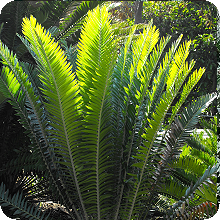| |||
| Division: Cycadophyta |
| Class: Cycadopsida |
| Order: Cycadales |
| Family: Zamiaceae |
| Genus: Encephalartos |
| Species: E. pterogonus |
Conservation Status: |

E. pterogonus
Toothed-cone CycadEncephalartos pterogonus was known from one small population located on the huge granite outcrop called Mount Mruwere (Monte Urueri) in the Manica province in central Mozambique (extent of occurrence is 35 km² and area of occupancy is less than 10 km²) and possibly from other adjacent hills. Most of the plants have been plundered by wealthy collectors and the species was declared extinct in its habitat by 1975, but some reports refer that there are at least 246 mature plants, 112 smaller plants and 300-400 seedlings that survived out of the initial 1,000 seedlings that were re-introduced. Another population on a nearby inselberg may also belong to E. pterogonus. The colony was never large.
It derives its name from the Latin pteron, meaning wing, and gonas, meaning seed - from the unusual wing-like structures or lobes which protrude from the lower edges of its pollen cone scales (microsporophylls) on male plants in habitat.
Closely related to the E.Manikensis, the stem of this specie can reach up to 1.5m in height with a diameter of 40cm, stems which are textured with large and small leaf-based scars. The light green leaves reach 1.5m long and are straight and held upwards but spread outwards with age. The leaflets gradually reduce in size towards the base of the rachis, culminating in a series of trifid or bifid prickles. Female cones are barrel-shaped and have a bright glossy green colour while the seeds are scarlet or orange red. This specie is suited to cool tropical and sub-tropical regions, will grow in full sun or partial shade and the frost tolerance is not high.
Cultivation:
Encephalartos pterogonus is a vigorous grower and does best in deep well-drained sandy loam in full sun. It responds to regular watering and fertilization. It dislikes frost. It is very difficult to get to cone. Tends to sucker well and is very adaptable in cultivation. The seedlings grow rapidly, developing into an attractive garden plant with 1 m long leaves in four to five years.
It is an adaptable plant well suited to subtropical climates. It can be grown in full sun without its leaves burning. Seedlings can be a little slow to get started for the first couple of years if they are grown in containers which do not allow room for the tap root to develop.
It grows in all sorts of soil type, but prefer well-drained, gritty soil with plenty of water, especially in dry weather. This species transplants easily as a mature plant, although it is recommended to remove all of the leaves before doing so. This makes for easier handling and the plant will recover sooner due to less moisture loss.
| semi-shade | green | medium watering | fast growth | frost-sensitive | rare |
Encephalartos pterogonus is a vigorous grower and does best in deep well-drained sandy loam in full sun. It responds to regular watering and fertilization. It dislikes frost. It is very difficult to get to cone. Tends to sucker well and is very adaptable in cultivation. The seedlings grow rapidly, developing into an attractive garden plant with 1 m long leaves in four to five years.
It is an adaptable plant well suited to subtropical climates. It can be grown in full sun without its leaves burning. Seedlings can be a little slow to get started for the first couple of years if they are grown in containers which do not allow room for the tap root to develop.
It grows in all sorts of soil type, but prefer well-drained, gritty soil with plenty of water, especially in dry weather. This species transplants easily as a mature plant, although it is recommended to remove all of the leaves before doing so. This makes for easier handling and the plant will recover sooner due to less moisture loss.
Available E. pterogonus at Africa Cycads:
